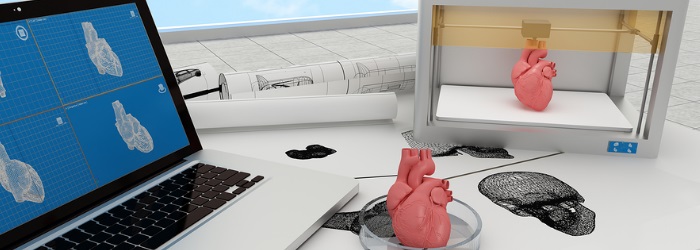How 3D Printing Has Made Personalized Medical Care a Reality

Born with a large hole in her heart, two-year old Mina Khan was at the losing end of her battle with life and death. As she counted her days, hoping against hope for a miracle to happen, a team of doctors at St. Thomas Hospital, London decided to take an unusual course to redress her malaise. They took MRI and CT scans to develop an accurate 3D model of her tiny heart, examined it from close range, gathered an understanding of what they could possibly find and then proceeded to create a custom GORE-TEX® patch, to plug the hole and give her a fresh lease of life. In yet another incredible feat, a 20 year old accident victim’s skull was successfully replaced with a 3D-printed implant.
These two instances just provide a glimpse of the potential of 3D printing technology to transform the medical world. We are fast sailing into a world of personalized Medicare where physicians would apply physical solutions of any shape and size only after analyzing patient-specific data. Most significantly, the quality of health solutions with 3D printed implants would be far improved. For example, customized orthopedic implants – such as jaw surgeries, knee replacements and other joint-related procedures – fit well and perform much better.
Addressing the Time & Cost factor in an Amazingly Effective Way
Many hospitals are moving to 3D printed implants to save on time and costs. It reduces surgical time because it is less invasive and requires shorter anesthetic times thus leading to early discharge of patients. In a few years from now, the time needed for complex surgical procedures will be cut down further when the process to print patient-specific 3D implants is made available real-time and in the middle of a surgery.
Osiris Biomed 3D, a biomedical company, plans for a game changing concept, the fruition of which will ensure an implant, printed and surgically grafted on the operating table. Once this evolves fully it would also lead to the decrease of the number of surgical operations and hospital visits for patients.
Costs wise the benefits are equally huge and promising. For instance, medical device companies find manufacturing conventional transradial prosthetics an economically unviable option because the market need for prosthetics pales into insignificance when compared to its total market value.
This has spiked costs to exorbitant levels and denied tens of thousands of limbless people a chance to live better lives. Today, with the advent of 3D printing, the tables have been turned. Even consumer-grade 3D printers can be used to print cost-effective prosthetic devices in less than six hours at a mere $100 per limb. Not Impossible Labs, a tech solutions company, which has leveraged 3D printing to produce low-cost prosthetic limbs for Sudan’s war ravaged victims, has shown the world the way to use the technology for a larger cause.
Thanks to 3D printing, researchers now feel they are closer to engineering livers, kidneys, and other organs and tissues in labs. Once this happens, we will have easy answers to a host of medical complications. But to make this happen, we need to thoroughly train our healthcare practitioners with this new technology. The answer, perhaps lies in blending medical science learning with 3D technology knowledge so that we embrace a promising discipline at the onset and nurture bazillions of bubbling ideas to transform the medical world.
